The portable hydrogen powered generator market is estimated to be valued at USD 1.5 billion in 2025 and is projected to reach USD 4.8 billion by 2035, registering a compound annual growth rate (CAGR) of 12.6% over the forecast period. A 10-year growth comparison shows a robust early-phase expansion followed by steady, sustained growth. Between 2025 and 2030, the market grows from USD 1.5 billion to USD 3.0 billion, contributing USD 1.5 billion in growth, with a CAGR of 15.5%. This early growth is driven by increasing demand for clean, portable power solutions across various industries, particularly in off-grid and remote areas where access to traditional energy sources is limited.
The growing interest in hydrogen as a clean, renewable energy source further accelerates adoption, with key sectors such as construction, outdoor activities, and emergency backup power showing significant demand. From 2030 to 2035, the market continues to expand from USD 3.0 billion to USD 4.8 billion, contributing USD 1.8 billion in growth, with a slightly lower CAGR of 9.5%. The deceleration in growth rate reflects the market approaching maturity, with the technology becoming more widely adopted. Despite this, continued advancements in hydrogen fuel cell technology, coupled with increasing government support for sustainable energy solutions, ensure steady market expansion. The growth comparison shows strong early acceleration followed by stable growth as hydrogen-powered generators become more integrated into mainstream energy systems.
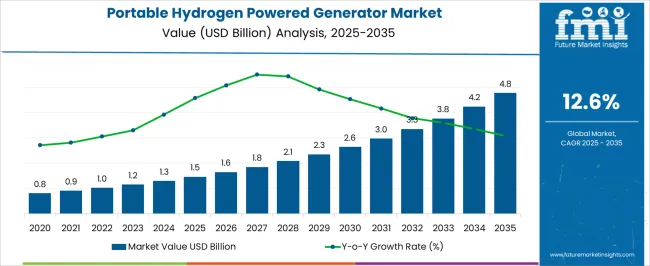
| Metric | Value |
|---|---|
| Portable Hydrogen Powered Generator Market Estimated Value in (2025 E) | USD 1.5 billion |
| Portable Hydrogen Powered Generator Market Forecast Value in (2035 F) | USD 4.8 billion |
| Forecast CAGR (2025 to 2035) | 12.6% |
The portable hydrogen powered generator market is experiencing steady expansion driven by rising demand for clean and efficient off grid power solutions. Growing concerns about carbon emissions and the environmental impact of fossil fuel based generators are pushing industries and households toward hydrogen fueled alternatives.
Technological advancements in fuel cell systems, combined with declining costs of green hydrogen production, are enhancing the feasibility of portable hydrogen powered units across diverse applications. Additionally, energy transition goals and government incentives supporting renewable technologies are encouraging early adoption in both developed and emerging markets.
As power reliability becomes increasingly critical for mobile operations, emergency preparedness, and rural electrification, portable hydrogen generators are emerging as an attractive solution due to their low noise, zero emission output, and high energy density. The market outlook remains positive with strong growth potential expected across residential, commercial, and temporary infrastructure sectors.
The portable hydrogen powered generator market is segmented by power rating, application, end use, and geographic regions. By power rating, the portable hydrogen powered generator market is divided into ≤ 10 kVA, > 10 kVA - 100 kVA, > 100 kVA – 200 kVA, and > 200 kVA. In terms of application, the portable hydrogen powered generator market is classified into Standby, Peak shaving, and Prime power. Based on end use, the portable hydrogen powered generator market is segmented into Residential, Commercial, and Industrial. Regionally, the portable hydrogen powered generator industry is classified into North America, Latin America, Western Europe, Eastern Europe, Balkan & Baltic Countries, Russia & Belarus, Central Asia, East Asia, South Asia & Pacific, and the Middle East & Africa.
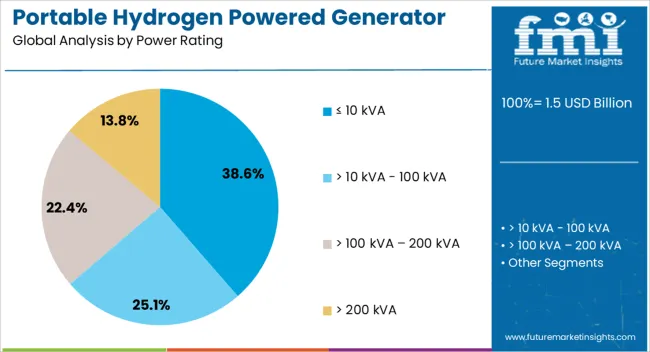
The segment with power rating up to 10 kVA is projected to account for 38.60% of total market revenue by 2025, making it the most significant within the power rating category. This dominance is due to the segment’s suitability for lightweight, compact, and easily transportable generator units that meet the needs of individual users, small appliances, and light duty backup systems.
These generators are particularly favored for off grid cabins, outdoor events, mobile workstations, and emergency power setups. Their low fuel consumption and ease of maintenance have further supported widespread use in personal and remote applications.
As users increasingly seek sustainable and mobile energy alternatives, this power class has established itself as the leading choice in the market due to its functional versatility and accessibility.
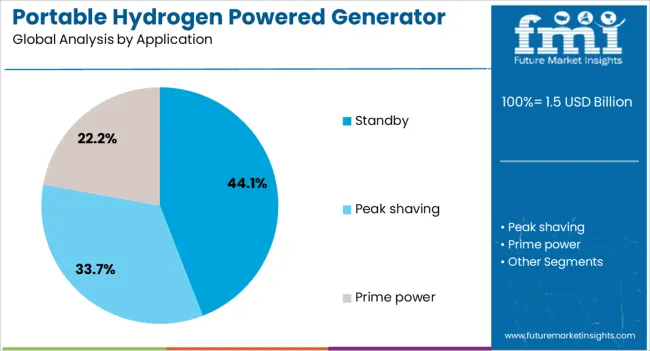
The standby segment is expected to capture 44.10% of the total market share by 2025 within the application category, positioning it as the leading application area. This prominence is driven by rising demand for reliable backup power solutions in residential and light commercial settings, where power continuity is crucial during grid failures.
Hydrogen powered standby generators are being recognized for their ability to deliver uninterrupted power without emissions or noise, making them attractive for both indoor and outdoor deployment. Their compatibility with renewable energy systems, such as solar, allows them to operate as clean backup modules in hybrid configurations.
As climate induced weather disruptions and infrastructure vulnerabilities become more frequent, the role of standby hydrogen generators in emergency preparedness and backup support continues to expand.
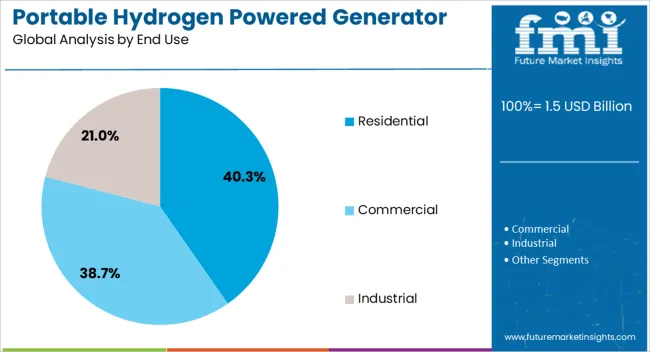
The residential segment is projected to hold 40.30% of the overall market revenue by 2025 under the end use category, making it the dominant sector. This leadership is attributed to increasing adoption of green technologies by homeowners and the need for dependable off grid or supplemental power in urban and rural settings.
Consumers are increasingly opting for portable hydrogen powered generators to reduce dependence on diesel based systems and to contribute to environmental sustainability goals. Features such as low maintenance, silent operation, and ease of transport align with modern residential energy preferences.
Additionally, government rebates and clean energy incentives targeted at household level adoption are accelerating market penetration. With growing energy demands and a focus on sustainability at the consumer level, the residential sector remains the primary driver in the market.
The portable hydrogen-powered generator market is gaining momentum as industries and consumers increasingly seek clean and efficient power solutions. Hydrogen-powered generators offer a sustainable alternative to traditional fuel-based generators by producing zero-emission electricity. These generators are ideal for remote locations, emergency backup power, and outdoor activities where portability and reliability are crucial. The rising emphasis on reducing carbon footprints and the growing adoption of hydrogen as an energy source are driving the demand for portable hydrogen-powered generators. With advancements in fuel cell technology, the market is poised for growth, offering a cleaner, quieter, and more efficient power solution.
The increasing demand for clean energy solutions is a key driver for the growth of the portable hydrogen-powered generator market. As governments and industries focus on reducing carbon emissions and moving toward renewable energy sources, hydrogen-powered generators present an ideal alternative to conventional fossil fuel generators. These generators produce power with zero emissions, making them an attractive solution for users looking to minimize their environmental impact. Moreover, the demand for reliable off-grid power solutions, especially in remote areas or during emergencies, is driving the adoption of hydrogen-powered generators, as they offer portability and autonomy without reliance on traditional fuel sources.
Despite the growing interest in portable hydrogen-powered generators, there are several challenges that hinder their widespread adoption. One of the main barriers is the high initial cost of hydrogen fuel cells and the generator systems themselves, which makes them less accessible compared to conventional generators. The infrastructure for hydrogen production, storage, and distribution remains limited, particularly in remote or rural areas where portable generators are in high demand. The lack of refueling stations and the complex logistics of transporting hydrogen fuel also pose challenges to the market’s growth. Overcoming these barriers requires advancements in fuel cell technology and a more widespread hydrogen infrastructure.
The portable hydrogen-powered generator market offers significant opportunities driven by advancements in fuel cell technology and the expansion of hydrogen infrastructure. Recent developments in hydrogen fuel cells have improved their efficiency, durability, and cost-effectiveness, making them more competitive with traditional power sources. As fuel cell technology continues to evolve, the cost of hydrogen-powered generators is expected to decrease, making them more accessible to a wider range of consumers. The development of hydrogen refueling infrastructure, including more hydrogen production and distribution facilities, presents an opportunity for broader market adoption. With governments and businesses investing in green energy initiatives, the market for portable hydrogen-powered generators is poised for continued growth.
A key trend in the portable hydrogen-powered generator market is the increasing integration of hydrogen power in mobile and backup power solutions. As industries, outdoor enthusiasts, and disaster response teams seek reliable and portable energy sources, hydrogen-powered generators are gaining traction due to their lightweight design, long-lasting power, and low noise levels. There is also a growing trend towards hybrid solutions that combine hydrogen fuel cells with solar or battery backup systems, providing more versatile power options for off-grid and emergency use. The advancements in miniaturization are enabling the development of smaller, more compact hydrogen-powered generators that are ideal for mobile applications, further driving the demand for portable, clean energy solutions.
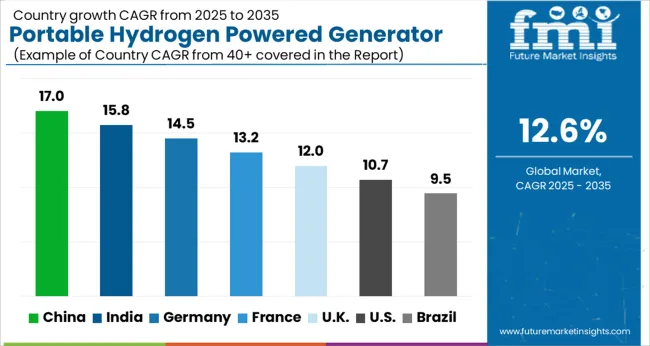
The portable hydrogen-powered generator market is projected to grow at a global CAGR of 12.6% from 2025 to 2035, driven by increasing adoption of clean energy solutions and the growing demand for sustainable power sources. China leads with 17.0% growth, fueled by strong domestic manufacturing capabilities and a focus on renewable energy. India follows at 15.8%, supported by growing energy demand and off-grid solutions. France, the UK, and the USA show steady growth, driven by government incentives, carbon reduction goals, and the need for reliable, eco-friendly backup power solutions. The analysis includes over 40+ countries, with the leading markets detailed below.
Demand fo portable hydrogen-powered generator in China is projected to grow at a CAGR of 17.0% through 2035. As a leader in renewable energy adoption and hydrogen infrastructure, China’s push toward clean energy solutions significantly boosts the demand for hydrogen-powered generators. With the government’s commitment to reducing carbon emissions and investing in green technologies, the market benefits from increased investments in hydrogen energy production and distribution. China’s growing demand for backup power solutions in both industrial and residential sectors further fuels the growth of portable hydrogen-powered generators, supporting the country’s goal of cleaner and more sustainable energy sources.
India is expected to grow at a CAGR of 15.8% through 2035 in the portable hydrogen-powered generator market. The country’s rapidly expanding energy sector and rising demand for clean energy solutions create a favorable environment for the adoption of hydrogen-powered generators. India’s increasing need for off-grid power solutions, coupled with its government’s push to improve energy efficiency and reduce reliance on fossil fuels, supports the growth of this market. As the country faces power shortages in rural and remote areas, hydrogen generators offer a cleaner and more sustainable alternative to conventional diesel-powered generators, fostering widespread adoption.
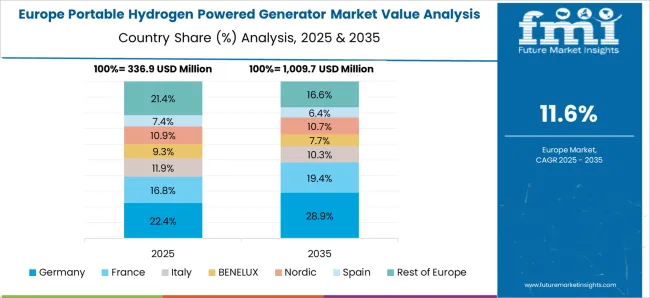
France is projected to grow at a CAGR of 13.2% through 2035 in the portable hydrogen-powered generator market. The country's strong commitment to green energy, combined with its leadership in the European hydrogen economy, supports the rising demand for hydrogen-powered solutions. France’s government-backed incentives for the adoption of clean energy technologies, along with the increasing need for efficient backup power in both urban and rural areas, drive the growth of portable hydrogen-powered generators. The market benefits from the growing industrial and residential sectors’ demand for reliable energy solutions, aligning with France's renewable energy goals.
The UK is expected to grow at a CAGR of 12.0% through 2035 in the portable hydrogen-powered generator market. With a growing emphasis on carbon reduction and sustainable energy practices, the UK is rapidly adopting clean energy solutions, including hydrogen-powered generators. The country's commitment to net-zero emissions by 2050 aligns with the growing demand for backup and off-grid power solutions, especially in industries requiring reliable, eco-friendly energy sources.The government’s role in promoting hydrogen infrastructure and supporting renewable energy projects creates a favorable environment for market growth, encouraging both residential and commercial adoption.
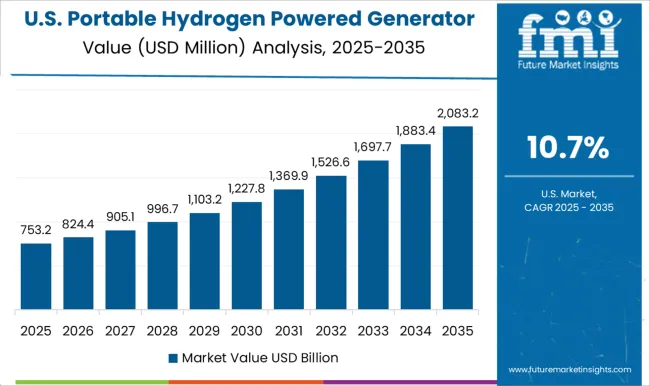
The portable hydrogen-powered generator market in the USA is projected to grow at a CAGR of 10.7% through 2035. The country’s ongoing transition to cleaner energy, along with its push for renewable energy adoption, supports the growth of hydrogen-powered generators. The USA market is experiencing increased demand for sustainable power solutions, particularly in industries where reliable backup power is crucial, such as in construction, telecommunications, and emergency services. Government policies promoting clean energy, combined with growing environmental awareness, are key factors driving the adoption of hydrogen-powered generators as an alternative to conventional fossil fuel-based solutions.
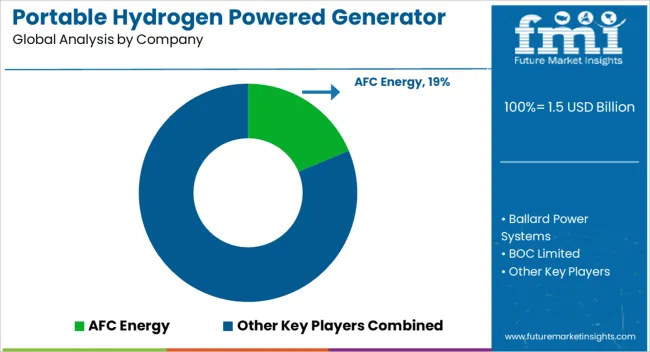
The portable hydrogen powered generator market is driven by companies that provide clean, efficient, and sustainable power solutions for various applications such as off-grid power generation, emergency backup, and outdoor activities. AFC Energy is a leading player, focusing on the development of hydrogen fuel cell technologies that deliver portable and high-performance power generation solutions with minimal environmental impact. Ballard Power Systems offers a wide range of hydrogen fuel cell-based generators, emphasizing long-lasting performance and eco-friendly power production.
BOC Limited provides hydrogen-based power solutions, utilizing hydrogen fuel cells for portable generators, catering to industrial and commercial applications. EODev offers cutting-edge hydrogen-powered generators, focusing on providing clean, reliable, and cost-effective energy for sectors like maritime and temporary power needs, reducing dependence on fossil fuels. Generac Power Systems Inc. is recognized for its hydrogen-powered portable generators, offering a sustainable alternative to traditional gas-powered units, widely used in home, commercial, and industrial applications. H2SYS specializes in the design and production of hydrogen-powered energy solutions, targeting small-scale power generation for off-grid applications, outdoor activities, and emergency backup. Helion Hydrogen Power focuses on delivering compact and portable hydrogen fuel cell solutions for a variety of industries, including transportation and energy. Hyfindr GmbH offers hydrogen fuel cell-based portable power solutions, catering to sectors requiring off-grid, reliable energy generation for various applications, including outdoor activities. Idroenergy is involved in hydrogen-powered power solutions, specializing in integrating hydrogen fuel cells into off-grid and emergency power applications. Intelligent Energy Limited provides innovative portable hydrogen fuel cell systems known for their high efficiency and low emissions, supporting both commercial and industrial needs. NUVERA FUEL CELLS, LLC develops hydrogen-powered generators and fuel cell systems that offer clean energy solutions, with a focus on performance, reliability, and scalability. Panasonic Holdings Corporation has entered the market with advanced hydrogen-powered portable generators, providing eco-friendly solutions for outdoor and emergency applications.
Plug Power Inc. is a prominent player in the market, offering hydrogen-powered generators and fuel cells for commercial use, with a focus on clean energy production and fuel cell technology. SFC Energy AG provides hydrogen fuel cell-based portable power solutions for off-grid, military, and industrial applications, known for their reliability and high efficiency. TW Horizon Fuel Cell Technologies focuses on providing hydrogen fuel cell systems and portable generators that cater to the growing demand for sustainable energy solutions, especially in areas with limited access to grid power.
| Item | Value |
|---|---|
| Quantitative Units | USD 1.5 Billion |
| Power Rating | ≤ 10 kVA, > 10 kVA - 100 kVA, > 100 kVA – 200 kVA, and > 200 kVA |
| Application | Standby, Peak shaving, and Prime power |
| End Use | Residential, Commercial, and Industrial |
| Regions Covered | North America, Europe, Asia-Pacific, Latin America, Middle East & Africa |
| Country Covered | United States, Canada, Germany, France, United Kingdom, China, Japan, India, Brazil, South Africa |
| Key Companies Profiled | AFC Energy, Ballard Power Systems, BOC Limited, EODev, Generac Power Systems Inc., H2SYS, Helion Hydrogen Power, Hyfindr GmbH, Idroenergy, Intelligent Energy Limited, NUVERA FUEL CELLS, LLC, Panasonic Holdings Corporation, Plug Power Inc., SFC Energy AG, and TW Horizon Fuel Cell Technologies |
| Additional Attributes | Dollar sales by product type (hydrogen fuel cell generators, backup power generators, off-grid generators) and end-use segments (residential, commercial, industrial, outdoor, military). Demand dynamics are influenced by the increasing focus on clean energy, the rising adoption of hydrogen technologies in power generation, and the demand for portable, reliable power solutions in off-grid and emergency situations. Regional trends show strong growth in North America, Europe, and Asia-Pacific, where hydrogen technology adoption is gaining momentum. Innovation trends focus on improving the efficiency, scalability, and affordability of hydrogen fuel cell systems, while environmental considerations include reducing greenhouse gas emissions and the need for sustainable energy solutions in portable power generation. |
The global portable hydrogen powered generator market is estimated to be valued at USD 1.5 billion in 2025.
The market size for the portable hydrogen powered generator market is projected to reach USD 4.8 billion by 2035.
The portable hydrogen powered generator market is expected to grow at a 12.6% CAGR between 2025 and 2035.
The key product types in portable hydrogen powered generator market are ≤ 10 kva, > 10 kva - 100 kva, > 100 kva – 200 kva and > 200 kva.
In terms of application, standby segment to command 44.1% share in the portable hydrogen powered generator market in 2025.






Full Research Suite comprises of:
Market outlook & trends analysis
Interviews & case studies
Strategic recommendations
Vendor profiles & capabilities analysis
5-year forecasts
8 regions and 60+ country-level data splits
Market segment data splits
12 months of continuous data updates
DELIVERED AS:
PDF EXCEL ONLINE
Portable Appliance Tester (PAT) Market Size and Share Forecast Outlook 2025 to 2035
Portable Boring Machines Market Size and Share Forecast Outlook 2025 to 2035
Portable Charging Units Market Size and Share Forecast Outlook 2025 to 2035
Portable Electronic Analgesic Pump Market Size and Share Forecast Outlook 2025 to 2035
Portable Ramps Market Size and Share Forecast Outlook 2025 to 2035
Portable Buffet and Drop-In Ranges Market Size and Share Forecast Outlook 2025 to 2035
Portable Cancer Screen Devices Market Size and Share Forecast Outlook 2025 to 2035
Portable Milling Machine Market Size and Share Forecast Outlook 2025 to 2035
Portable Power Quality Meter Market Size and Share Forecast Outlook 2025 to 2035
Portable Sandwich Maker Market Size and Share Forecast Outlook 2025 to 2035
Portable Projector Market Size and Share Forecast Outlook 2025 to 2035
Portable Printer Market Size and Share Forecast Outlook 2025 to 2035
Portable Video Wall Market Size and Share Forecast Outlook 2025 to 2035
Portable Gas Detection Equipment Market Size and Share Forecast Outlook 2025 to 2035
Portable Chromatography Systems Market Size and Share Forecast Outlook 2025 to 2035
Portable Band Saws Market Size and Share Forecast Outlook 2025 to 2035
Portable Cannabis Vaporizer Market Size and Share Forecast Outlook 2025 to 2035
Portable Cardiology Ultrasound Systems Market Size and Share Forecast Outlook 2025 to 2035
Portable Dishwasher Market Analysis - Size, Growth, and Forecast 2025 to 2035
Portable Ultrasound Bladder Scanner Market Analysis - Size, Share, and Forecast Outlook 2025 to 2035

Thank you!
You will receive an email from our Business Development Manager. Please be sure to check your SPAM/JUNK folder too.
Chat With
MaRIA